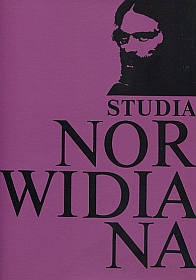Norwid and the Topos of Anticipation (transl. by Jacek Scholz)
Abstract
There have been a host of poets who, denied due recognition by their contemporaries, were the more readily granted posthumous rehabilitation as forerunners of later epochs. This peculiar reception phenomenon was particularly frequent in the case of the rejected Romantic poets. Let us venture to mention in one group such names as Hölderlin, Mácha, Nerval, Baudelaire, Lautréamont and Norwid. The work of the post-Romantic poet Cyprian Norwid, because of its extraordinarily wide-spread late reception during the periods of symbolism and the Cracow Avant-garde, is particularly well suited for the study of the topos of literary precursorship
The topos of anticipation is a powerful thing: even those scholars who do not agree that Norwid came prematurely or that he was a precursor, but regard him as a product of his own time, must deal with it thoroughly (even if negatively). While it is a linguistic phenomenon, the topos of anticipation spreads in many ways into the meta-stratum of historical presentation of reception; it thus becomes a locus communis of the historiography of reception. Describing someone as a precursor is a colloquial opinion which expresses surprise. If that manner of speaking contributes anything to learned discourse, it usually does so on its periphery, in such texts as the feuilleton, the occasional essay, the blurb, and less commonly in argumentative texts.
The topos of anticipation furnishes a meeting point for the exercise of constructive memory and the conventional concept of time. One who speaks about anticipation establishes it as a historical relation. He constructs something that no one has thought of before, something that objectively could not have been stated by any predecessor (because one argument of the relation then still belonged to the future), that is, something that cannot be reconstructed. Memory creatively constructs history. In this way some hitherto unused elements of tradition, in the case in hand the work of Norwid, can be properly appreciated and activated, initially owing to individuals, in this case Miriam and Przyboś. This appreciation may subsequently encourage further reception, becomes part of the cultural canon and consolidates a „change of horizons in the process of aesthetic experience”.
Copyright (c) 1999-2000 Studia Norwidiana

This work is licensed under a Creative Commons Attribution-NonCommercial-NoDerivatives 4.0 International License.





